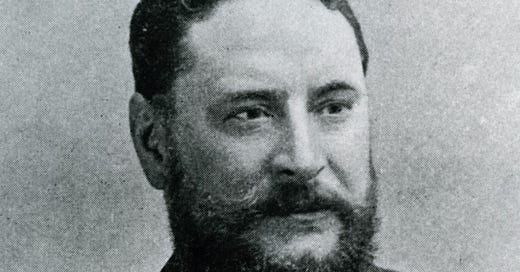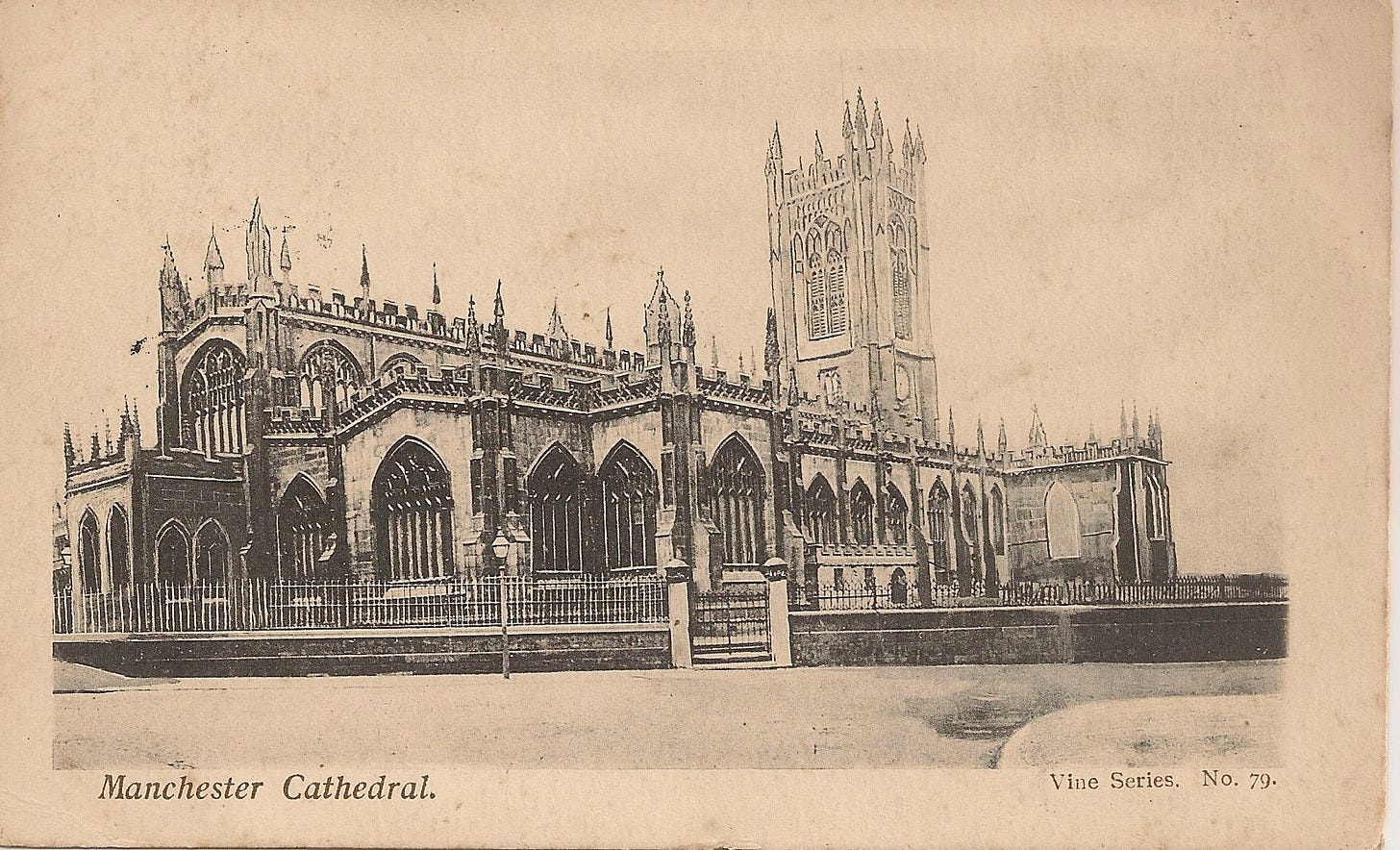My favourite Victorian detective is Jerome Caminada of the Manchester City Police, a super-sleuth and a real-life Sherlock Holmes. In 1889, he faced his greatest challenge; the Manchester Cab Mystery, for which he would need all the brilliant powers of deduction of his iconic fictional counterpart.
At 6.30 pm on 26 February 1889, a well-respected paper merchant hailed a cab on the steps of Manchester Cathedral. Slightly inebriated after an afternoon’s drinking, John Fletcher climbed into the hansom with a young man. The pair spent the next hour driving around the city, stopping for a drink in a public house. Later, they were heading towards a private address in Old Trafford, when a passerby called out to the cab driver that his fare had fled. Thinking that he might have been dodging payment, the cabman jumped down and peered into the carriage, to find Fletcher slumped in his seat in a semi-conscious state. His young companion had vanished. By the time they had arrived at the Manchester Royal Infirmary, John Fletcher was dead.
The next morning, the citizens of Manchester woke to the shocking news that a respectable businessmen had been murdered in a hansom cab, during a night out on the town. Anxious for their safety, the public followed the twists and turns of the ‘Manchester Cab Mystery’ with morbid fascination. The pressure was on for a quick resolution and, in order to prevent mass hysteria, the chief constable placed this puzzling mystery placed in the capable hands of Detective Chief Inspector Jerome Caminada.
On the trail
When John Fletcher’s body was examined at the Manchester Royal Infirmary, the surgeons found no obvious marks of violence and their initial conclusion was that he had died of alcohol poisoning. A habitual gin drinker, there was a lethal mix of alcohol and chloral hydrate – a chemical often used for insomnia – in his stomach contents. However, the absence of money and valuables on his person led Detective Caminada to believe that there was a more sinister explanation for his sudden death.
Caminada opened his investigation by interviewing witnesses in an attempt to piece together the victim’s final movements and gain a description of his elusive acquaintance. John Fletcher, aged 50, was the senior partner in a firm of paper manufacturers. A wealthy man, he was well known in the city, especially at the Exchange. By the time of his death, he had retired from active business, but was still working as a justice of the peace and a member of Lancashire County Council.
On 26 February, Fletcher, who was a widower, had left his home in Southport for a weekend in Knutsford, stopping in Manchester en route. After visiting the company’s offices and a mill auction, he was due to meet a colleague at a shellfish restaurant later that evening, but he never turned up. A police officer spotted him at a market stall in the company of a young man, half an hour before he hailed the cab.
PC William Jakeman described Fletcher’s companion as about 22 years old, 5 feet 2 inches tall, with a fresh, clean-shaven complexion, and wearing a dark-brown suit and a chimney pot hat. Detective Caminada interviewed several other witnesses who had seen him on the night in question, including the cabman. Their testimonies placed the suspect in a number of public houses throughout the city, both before and after the incident. One of the hostelries was the Locomotive Inn, a noted haunt of pugilists.
Despite the fact that the post-mortem was inconclusive about whether Fletcher had been deliberately poisoned, Caminada followed his instinct and deduced that there was a connection between the presence of chloral hydrate in the victim’s stomach contents and illegal prizefighting, as the drug was used to subdue opponents in the ring. Using his encyclopedic knowledge of the criminal fraternity, he compared the description of his suspect with likely candidates and soon came to the conclusion that the perpetrator might have been Charlie Parton, son of a beerhouse keeper, who was renowned for putting chloral hydrate into the water used by fighters so that he could rig the betting.
A timely resolution
Detective Caminada arrested 18-year-old Charlie Parton, at his parents’ home, four days after John Fletcher’s death. He was remanded in custody while Caminada built his case against him. The wily detective linked the murder with the recent theft of chloral hydrate from a druggist’s in Liverpool – Parton’s home city. He also found two previously intended victims of Parton. In separate incidents, both men had been on a night out with the suspect and woken up ‘drunk’ the following day, with their valuables missing. They had claimed that Parton had drugged and robbed them, but neither incident had been proven.
Charlie Parton was committed for trial at Liverpool Assizes, and it was between the court hearings that Caminada played his final card. Through his network of informants he located a key witness who had been present in the public house where Fletcher had spent his last evening. The witness revealed in court that he had seen Parton pouring liquid from a small vial into Fletcher’s beer. In the light of this compelling evidence, it took the jury just twenty minutes to return a unanimous verdict of ‘Guilty’. The ladies in the gallery sobbed and Parton clutched the rail of the dock as the judge donned his black cap – his death sentence was later commuted to life imprisonment.
The speedy resolution of the Manchester Cab Mystery was Detective Caminada’s finest moment; he had proved that John Fletcher had been murdered and he brought the perpetrator to justice in the record time of three weeks. This sensational case was widely reported in the national press, placing Caminada ‘in the foremost rank of the detectives in his day’ (Manchester Courier). Furthermore, this event took place just as the stories of Sir Arthur Conan Doyle were gaining in popularity, after Sherlock Holmes’s début in A Study in Scarlet two years earlier, in 1887, and Jerome Caminada was already becoming known as ‘Manchester’s Sherlock Holmes’.
You can find out more about Jerome Caminada in my book, The Real Sherlock Holmes.
In my next newsletter for paid subscribers, I’ll be examining the extraordinary life and crimes of the perpetrator of the Manchester Cab Mystery, Charlie Parton.









